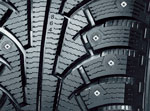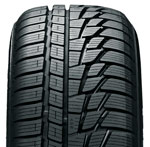Those who argue winter tires aren’t suitable for the UK climate use cite countries such as Norway, which experience solid snow and ice for many months at a time. This would be true if not for one small detail - extreme climates use a different type of winter tire to the UK / central Europe.
Extreme winter tires

An extreme studded winter tire
These extreme winter tires are not suitable for the UK climate, as they could wear very quickly in warmer conditions and offer poor grip compared to European winter tires in the dry and wet.
UK / European winter tires

A European Winter Tire (Nokian WRG2)
The data
To highlight the difference between the two types of tires Russian magazine AutoReview.ru challenged European winter tires against extreme studded and studless winter tires.Unsurprisingly the studded and extreme studless tires finished first and second in the ice test, stopping from 50km/h in 57.4 and 73.5 metres respectively. The best European winter tire, the Continental Winter Contact TS830 stopped in 81.8 metres.
Things were closer in the snow, with the extreme studless tires extra tread depth just beating the studded tire, stopping from 80km/h in 38.1m compared to 38.5m. Again, the best European winter tire was the Continental, stopping in a further 2 metres at 41m.
The results are reversed when the European winter tires get to their home turf - wet tarmac. Once again the Continental led the pack, stopping from 80km/h in 28.5m when both the extreme winter tires took over 35 metres to stop. In the dry, the Vredestein Snowtrac 3 stopped the shortest in just 29.9 metres with the extreme studless tire stopping in 32.1m
Further winter tire reading
- 7 reasons to consider winter tires- 2010 Winter tire buying guide
- Continental Winter Contact TS830







